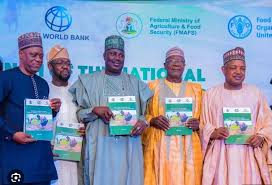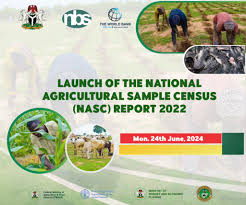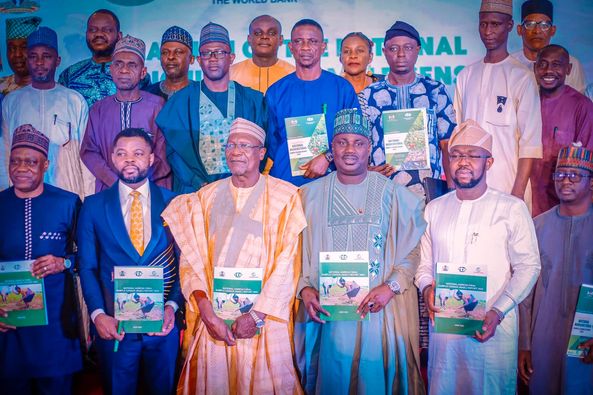
National Agricultural Sample Census (NASC) Launched by FG, FMAFS
…Only 7% of farming communities receive agricultural loans from banks in Nigeria – NBS
…Lagos and Ogun State has largest numbers of Farmers receiving bank loans.
…Minister of State appreciates Ministry of Budget & Planning, FAO, World Bank for supports.


A recently released report by the National Bureau of Statistics (NBS) revealed that only 7% of farming communities report receiving micro-credits from banks in Nigeria as of 2022.
The report titled, “National Agricultural Sample Census” was a collaborative research between the NBS, Federal Ministry of Budget and Planning, FAO, World Bank and others.
It reported that communities in Lagos and Ogun states had the highest number of farmers receiving agricultural credits from banks at 26% and 14% respectively.
Furthermore, the report also stated only 11% of agricultural communities had access to bank loans with most communities across the country reporting even much lower figures.
Also, the survey revealed that credit facilities from cooperative organisations were a more common medium of credit compared to the banks with about 24% of interviewed communities reporting availability of credit facilities from cooperative organisations.
The report concluded that these farming communities prefer loans from cooperative organisations over conventional banks as the former are less demanding in terms of collateral compared to the latter.

The report reads, “Data was also collected on the sources of agricultural credit available to members of the community. The community interview result reveals that such credit facilities were not common in Nigeria.”
“Overall, only seven per cent of the communities reported micro-credits and banks as sources of agricultural credit. However, about 14 per cent in Ogun State and about 26% in Lagos State reported micro-credits and banks as their sources of agricultural credit respectively.”
“Of the total communities interviewed, only 2,907 (11% ) reported that their members can borrow money from the banks. While in most of the States, availability of these loans from the banks is low, about 37% of the communities in Lagos State reported the availability of such loans.”
Low bank credit to the agricultural sector
The study sheds light on the difficulty of farming communities in accessing credit to boost their output and overall increase food production in the country. In 2023, of the N44.54 trillion loans given by banks to the private sector, only N2.26 trillion was extended to the agricultural sector- a meagre 5.07% to a sector that contributes over 20% to GDP.
Furthermore, commercial bank loans to the sector were the lowest among the top ten sectors of the Nigerian economy as seen in the Central Bank of Nigeria (CBN) report at the end of the year.
70% of households in Nigeria are involved in agriculture
The report also revealed that there are about 40.2 million households- 70% of total households in the country involved in agriculture with the bulk of the population- 91% involved in crop production while around 48% were involved in livestock farming.
The report revealed that the average farming household in Nigeria cultivates on average 3.3 plots of land with Ebonyi state being the highest at 5.9 plots per farming household while the lowest were farmers in Lagos state who on average cultivated 1.9 plots.
Nigeria’s huge number of people involved in agriculture contrasts with more advanced economies like the United States and Europe where around 2% and 4.5% of the total population are engaged in agriculture.
This denotes the severe low productivity and rampant subsistence farming that characterizes Nigeria’s food system.

This report marks the first national agricultural census since 1993, providing data on agricultural activities to enhance food and nutrition security and foster economic growth.
Speaking at the launch event in Abuja, Minister of State for Agriculture and Food Security, Senator Dr. Aliyu Sabi Abdullahi emphasized the importance of the data gathered from the census.
He noted that the information would support evidence-based policy and decision-making across various sectors of the economy, aligning with the renewed hope agenda in the agriculture sector.

The NASC report provides critical data on agricultural activities, including crop production, livestock, and fisheries. According to the report, Nigeria has approximately 40.2 million agricultural households, with 91% cultivating crops and 48% raising livestock.
The report also reveals that 16% of households raise cattle, 41.2% raise goats, and 42.5% raise poultry, with Lagos State recording the lowest percentage of agricultural households engaged in crop cultivation and Ebonyi State having the highest.
The report also highlights the importance of agriculture in the country, with over 65% of the population directly or indirectly dependent on the sector for their daily sustenance.
Statistician-General of the Federation and Chief Executive Officer of the NBS, Prince Adeyemi Adeniran, noted that the report provides a detailed picture of the size and structure of farm holdings, land use patterns, crop production practices, livestock and fisheries activities, and the use of agricultural inputs, among others.
The launch event was attended by key stakeholders, including the Minister of Budget and Economic Planning, Senator Abubakar Atiku Bagudu, and the Food and Agriculture Organization (FAO) Representative in Nigeria and ECOWAS, Dominque Koffy Kouacou. The report is expected to provide critical data for policymakers, aiding in planning, monitoring, and evaluating programs and budgets.
In his remarks, Senator Abdullahi noted, “The most significant thing about the data is that the government can now measure, and whatever you can measure, you can manage.”

